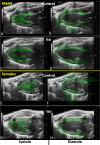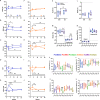Segmental analysis by speckle-tracking echocardiography of the left ventricle response to isoproterenol in male and female mice
- PMID: 33763310
- PMCID: PMC7958899
- DOI: 10.7717/peerj.11085
Segmental analysis by speckle-tracking echocardiography of the left ventricle response to isoproterenol in male and female mice
Abstract
We studied by conventional and speckle-tracking echocardiography, the response of the left ventricle (LV) to a three-week continuous infusion of isoproterenol (Iso), a non-specific beta-adrenergic receptor agonist in male and female C57Bl6/J mice. Before and after Iso (30 mg/kg/day), we characterized LV morphology and function as well as global and segmental strain. We observed that Iso reduced LV ejection in both male (-8.7%) and female (-14.7%) mice. Several diastolic function parameters were negatively regulated in males and females such as E/A, E/E', isovolumetric relaxation time. Global longitudinal (GLS) and circumferential (GCS) strains were reduced by Iso in both sexes, GLS by 31% and GCS by about 20%. For the segmental LV analysis, we measured strain, strain rate, reverse strain rate, peak speckle displacement and peak speckle velocity in the parasternal long axis. We observed that radial strain of the LV posterior segments were more severely modulated by Iso than those of the anterior wall in males. In females, on the other hand, both posterior and anterior wall segments were negatively impacted by Iso. Longitudinal strain showed similar results to the radial strain for both sexes. Strain rate, on the other hand, was only moderately changed by Iso. Reverse strain rate measurements (an index of diastolic function) showed that posterior LV segments were negatively regulated by Iso. We then studied the animals 5 and 17 weeks after Iso treatment. Compared to control mice, LV dilation was still present in males. Ejection fraction was decreased in mice of both sex compared to control animals. Diastolic function parameters, on the other hand, were back to normal. Taken together, our study indicates that segmental strain analysis can identify LV regions that are more negatively affected by a cardiotoxic agent such as Iso. In addition, cessation of Iso was not accompanied with a complete restoration of cardiac function after four months.
Keywords: Adrenergic suractivation; Cardiac toxicity; Heart; Isoproterenol; Mouse; Sex differences; Speckle-tracking echocardiography; Strain; Takotsubo syndrome.
©2021 Walsh-Wilkinson et al.
Conflict of interest statement
The authors declare there are no competing interests.
Figures




Similar articles
-
Differences of myocardial systolic deformation and correlates of diastolic function in competitive rowers and young hypertensives: a speckle-tracking echocardiography study.J Am Soc Echocardiogr. 2010 Nov;23(11):1190-8. doi: 10.1016/j.echo.2010.07.010. Epub 2010 Sep 1. J Am Soc Echocardiogr. 2010. PMID: 20810245
-
Global longitudinal strain and global circumferential strain by speckle-tracking echocardiography and feature-tracking cardiac magnetic resonance imaging: comparison with left ventricular ejection fraction.J Am Soc Echocardiogr. 2015 May;28(5):587-96. doi: 10.1016/j.echo.2014.11.018. Epub 2015 Jan 7. J Am Soc Echocardiogr. 2015. PMID: 25577185
-
Systolic Longitudinal Function of the Left Ventricle Assessed by Speckle Tracking in Heart Failure Patients with Preserved Ejection Fraction.J Tehran Heart Cent. 2015 Oct 27;10(4):194-200. J Tehran Heart Cent. 2015. PMID: 26985208 Free PMC article.
-
Left ventricular three-dimensional global systolic strain by real-time three-dimensional speckle-tracking in children: feasibility, reproducibility, maturational changes, and normal ranges.J Am Soc Echocardiogr. 2013 Aug;26(8):853-9. doi: 10.1016/j.echo.2013.05.002. Epub 2013 Jun 19. J Am Soc Echocardiogr. 2013. PMID: 23791113
-
Effects of increased left ventricular wall thickness on the myocardium in severe aortic stenosis with normal left ventricular ejection fraction: Two- and three-dimensional multilayer speckle tracking echocardiography.Echocardiography. 2017 Apr;34(4):511-522. doi: 10.1111/echo.13474. Epub 2017 Mar 23. Echocardiography. 2017. PMID: 28332215
Cited by
-
Establishment and effect evaluation of a stress cardiomyopathy mouse model induced by different doses of isoprenaline.Exp Ther Med. 2023 Feb 28;25(4):166. doi: 10.3892/etm.2023.11865. eCollection 2023 Apr. Exp Ther Med. 2023. PMID: 36936708 Free PMC article.
-
The Loss of Gonadal Hormones Has a Different Impact on Aging Female and Male Mice Submitted to Heart Failure-Inducing Metabolic Hypertensive Stress.Cells. 2025 Jun 9;14(12):870. doi: 10.3390/cells14120870. Cells. 2025. PMID: 40558497 Free PMC article.
-
A murine model of hypertensive heart disease in older women.PeerJ. 2024 May 23;12:e17434. doi: 10.7717/peerj.17434. eCollection 2024. PeerJ. 2024. PMID: 38799057 Free PMC article.
-
Cold Exposure Exacerbates Cardiac Dysfunction in a Model of Heart Failure with Preserved Ejection Fraction in Male and Female C57Bl/6J Mice.Biomedicines. 2025 Aug 4;13(8):1900. doi: 10.3390/biomedicines13081900. Biomedicines. 2025. PMID: 40868154 Free PMC article.
-
Biological sex, sex steroids and sex chromosomes contribute to mouse cardiac aging.Aging (Albany NY). 2024 May 13;16(9):7553-7577. doi: 10.18632/aging.205822. Epub 2024 May 13. Aging (Albany NY). 2024. PMID: 38742935 Free PMC article.
References
-
- Ali A, Redfors B, Lundgren J, Alkhoury J, Oras J, Gan LM, Omerovic E. Effects of pretreatment with cardiostimulants and beta-blockers on isoprenaline-induced takotsubo-like cardiac dysfunction in rats. International Journal of Cardiology. 2019;281:99–104. doi: 10.1016/j.ijcard.2018.12.045. - DOI - PubMed
LinkOut - more resources
Full Text Sources
Other Literature Sources
Miscellaneous

